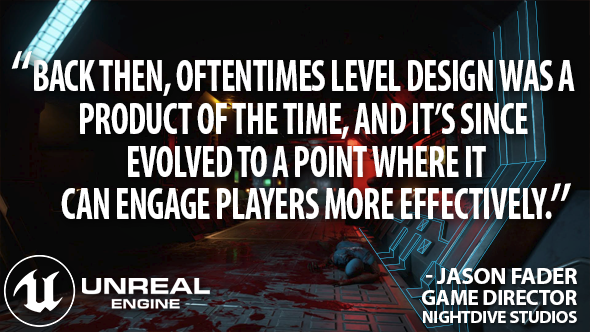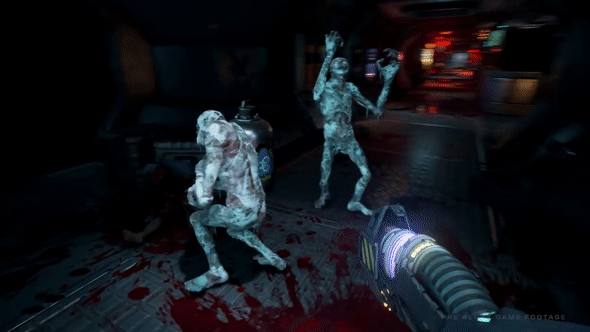
System Shock’s remaster already seemed beautiful greater than a 12 months in the past. Citadel Station, thought rendered out of date by 20 years of first-person style growth, was resplendent in that first trailer – a blue-green cathedral of colored lights and jittery post-humans. It was as if builders Nightdive had casually dropped the phrase ‘cyberspace’ into dialog and never solely bought away with it, however one way or the other made it sound correct once more – even related.
Related: the best first-person shooters on PC.
“All game content in this video is subject to change,” learn the disclaimer. It was powerful to think about why anybody would change something about this densely stylised sister to the Bioshock collection. Yet change it did.
Why did Nightdive shift the brand new System Shock from Unity to Unreal Engine four? And what’s new now that they’ve made the swap?
TriOptimisation
There have been two vital concerns behind the engine swap. First, after conversations with each Epic and Unity, Nightdive determined Unreal Engine four could be the higher selection for hitting their efficiency targets on consoles. And second, extra pertinent for our functions, was the crew. Nightdive have employed a bunch of “very senior” builders, quite a few whom labored alongside sport director Jason Fader at Obsidian on Fallout: New Vegas.
“These guys had more Unreal experience than Unity experience,” explains Fader. “And instead of having them get up to speed on Unity, it made more sense with what we had in the pipeline to go with an Unreal ecosystem.”
Thankfully, Nightdive have been capable of pull over a “good chunk” of the work they’d already accomplished in pre-alpha.
“The code doesn’t really translate, but the core fundamentals of the system we were working on definitely do map over,” says Fader.
Creature design, objects, weapons, and to a sure diploma environmental layouts – all have been translated from the Unity demo with a minimal of time misplaced. In March, lower than a 12 months after the preliminary reveal, Nightdive put out one other trailer in Unreal.
“Overall, it’s been a pretty seamless transition,” Fader concludes. “I guess what we showed off in the Unreal trailer was more of a tech demo than a final representation of the art style. It was just something we wanted to put together to show that we were making something: it’s in Unreal, and Unreal will help us to get better visual fidelity at the same time on multiple platforms.”
A modular Citadel
Ask Ken Levine about working in Thief’s Dark Engine for System Shock 2 and he’ll inform you about carving passageways into the editor, as if house itself was constituted of dense rock. Rebuilding Citadel for the brand new System Shock couldn’t be extra completely different – the crew used a tile-based building system paying homage to the one Fader and far of his crew labored with on Fallout: New Vegas.
“What that means is that we have our environment artist creating tiles – chunks of a level, chunks of a hallway, wall pieces, floor pieces, ceiling pieces,” Fader explains. “And then they go away and construct these things, almost like working with a digital set of Lego.”
The system permits them to get ranges up and operating rapidly, and Fader believes modular design is even higher suited to System Shock than it was to Fallout: “Mainly because we don’t have to worry too much about terrain and extreme environments, and fortunately a space station already feels modular in its construction.”
An concern that Bethesda have run into up to now is ‘asset fatigue’. It’s that uncanny sense, on the 20th Ayleid dungeon, that you simply’ve seen that very same set of sarcophagi earlier than. Once you’ve observed, it’s laborious to shake – and it’s one thing Nightdive are working to keep away from.
“One of the strategies we’ve adopted from past games that we’ve worked on is that it’s not necessarily about the environment, it’s about what you put in it,” says Fader. “We can have a game where you see a lot of viscera strewn about the station, and there’s a lot of opportunity for visual storytelling.”
A hall in an area station won’t in itself set the trade alight with its visible inventiveness. But the way in which it’s dressed, with cybernetic doohickies, physique elements, and dramatic lighting, can play on our fears and make it distinctive.

Of course, Nightdive are considerably wedded to maps drawn up by Looking Glass in 1994. That’s no dangerous factor – there have been few, if any studios within the ‘90s, with greater pedigree in that area – but the team aren’t letting the constraints of two-decades-old degree enhancing maintain them again.
“Back then, oftentimes level design was a product of the time, and it’s since evolved to a point where it can engage players more effectively,” notes Fader. “There are areas where we could make that aspect of the game more fun by opening the level up more or making it a little less maze-like, and adding more areas of interest to show exactly what they’ve done to create these cyber monstrosities. It really gives us a lot of flexibility.”
Murder within the frozen aisle
The most placing a part of System Shock’s Unreal Engine four trailer – extra tech demo than consultant slice of the sport – was the second a few mutants have been frozen stable by a close-by gasoline canister. Using a wrench, the participant was capable of knock heads and limbs off the station’s new statues, which keeled over and shattered on the laborious steel ground.
“You’re on a space station, it’s very cold,” argues Fader. “There are a lot of cooling systems going throughout the station, and we want to give players a lot of cool opportunities to interact with these physics systems.”
The crew seemed on the approach freezing was dealt with in Bioshock and Mass Effect, however discovered their options missing.

“Their technology is limited in that it’s not target-based destruction,” Fader expands. “If you swing a pipe at something that’s frozen in Bioshock, the whole entire thing shatters, and there’s no actual feedback as to what you’re hitting. We want to take it a step further.”
For System Shock, Nightdive have been working with an Nvidia bundle that may flip a non-static mesh – i.e. a dwelling, lurching mutant – and switch it right into a static mesh, in order that it primarily turns into an object on this planet. That object is then topic to locational destruction in a approach it wasn’t simply moments earlier than.
“What you saw in the trailer was our first pass at that technology,” says Fader. “Since then, our lead programmer Matthew Kenneally has been hard at work refining it. What we’ll show in future trailers will definitely be more impressive than what you saw before.”
Source


